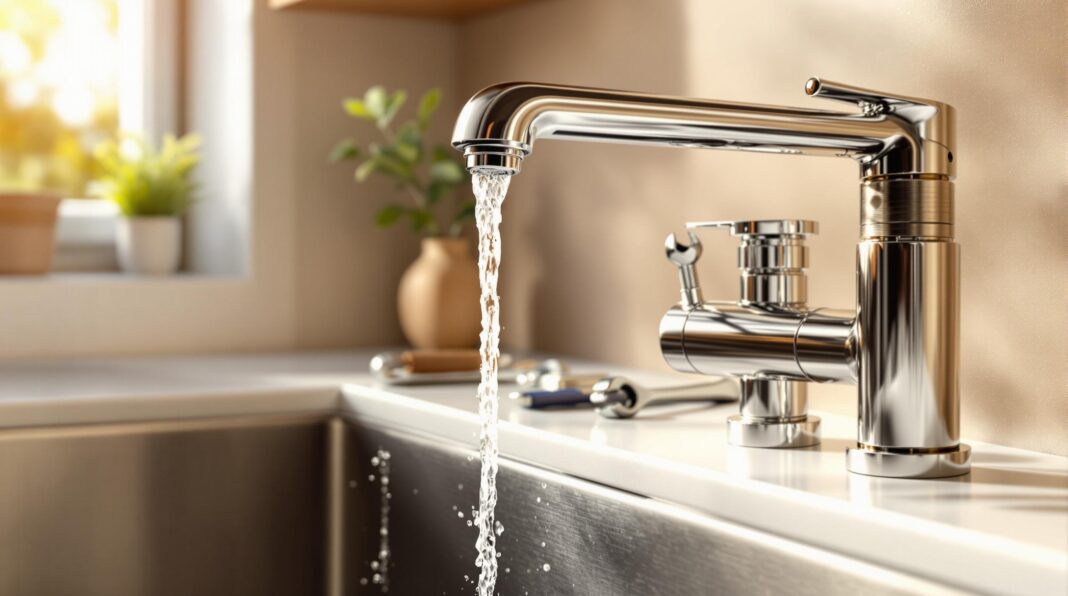A leaky faucet wastes up to 20 gallons of water daily, increasing your utility bills. The good news? You can fix it yourself for just $20–$50 using basic tools instead of paying a plumber $100–$300. Here’s how:
- Identify your faucet type: Compression, ball, cartridge, or ceramic disk.
- Gather tools: Wrench, pliers, screwdrivers, plumber’s tape, and replacement parts.
- Follow repair steps: Replace worn washers, O-rings, or cartridges based on faucet type.
- Prevent future leaks: Regular maintenance, cleaning, and inspections.
Fixing leaks saves water, money, and prevents bigger issues. Let’s dive into the details.
How to Fix a Leaky Faucet
Types of Faucets
Knowing your faucet type is key – each design has unique parts and repair methods. This helps you follow the right steps for fixing it later.
Compression Faucets
Compression faucets come with separate hot and cold handles and rely on rubber washers or O-rings to seal the valve seat. These are often found in older homes, and leaks usually happen when the washers or O-rings wear out.
A compression faucet (also called a stem or washer faucet) has two handles and one spout. If your faucet has separate hot and cold handles, it’s likely a compression faucet.
Ball Faucets
Ball faucets use a single lever to control both water temperature and flow. Inside, they have a ball mechanism that manages water regulation. Because of their intricate design, repairing them often requires a specific repair kit.
Cartridge Faucets
Cartridge faucets are built with a replaceable cartridge that allows for smooth, quarter-turn operation. They can have one or two handles, making them easier to use compared to compression faucets, which need multiple rotations.
Ceramic Disk Faucets
Ceramic disk faucets operate with two ceramic disks sliding against each other to manage water flow. They typically have a single lever and are known for their durability and straightforward use.
Take photos of the internal parts as you disassemble the faucet. This makes it easier to find matching replacement parts when needed.
Before You Start
Getting ready is crucial: make sure you have the right tools and take proper safety precautions to ensure the repair goes smoothly. Once you’re set, check the tool requirements below.
Required Tools
You’ll need these basic tools:
- Adjustable wrench
- Slip-joint pliers
- Phillips and flathead screwdrivers
- Penetrating oil
- Clean rags
- Bucket
- Plumber’s tape
Faucet-Specific Parts:
| Faucet Type | Required Parts |
|---|---|
| Compression | Rubber washers (3/8" to 5/8"), O-rings, packing nuts |
| Ball | Complete repair kit with cam, washer, and ball |
| Cartridge | Replacement cartridge matching your model |
| Ceramic Disk | Neoprene seals |
Safety Steps
Before taking apart your faucet, follow these safety measures to avoid any mishaps:
Water Shutoff:
- Find the shutoff valves under the sink and turn them clockwise.
- Open the faucet to let any remaining water drain and confirm the water is off.
Personal Protection:
- Wear gloves and safety glasses for protection.
- Place a bucket under the faucet to catch any water.
Workspace Setup:
- Clean the faucet and area around it with mild soap.
- Arrange your tools where you can easily access them.
Repair Steps by Faucet Type
Here’s a detailed guide to fixing different types of faucets. Follow these instructions based on the faucet type you’re dealing with.
Fixing Compression Faucets
Compression faucets are commonly found in older homes. Leaks here are usually caused by worn-out washers.
- Handle and Stem Removal: Start by removing the decorative cap and unscrewing the handle. Loosen the packing nut with an adjustable wrench, then take out the stem. Keep track of all the parts for easy reassembly.
- Washer Replacement: Unscrew the rubber washer from the stem’s bottom end and replace it with a matching size. Apply a light coat of plumber’s grease to the new washer before reassembling.
Fixing Ball Faucets
Ball-type faucets are a bit more complicated and require a repair kit for proper fixes.
- Initial Disassembly: Remove the handle, then unscrew the cap and collar. Take out the ball assembly, noting its orientation. Using needle-nose pliers, remove the inlet screws and springs.
- Parts Replacement: Replace worn components like O-rings, cam washers, valve seats, and springs with parts from your repair kit. Make sure everything is aligned correctly during reassembly.
Fixing Cartridge Faucets
Cartridge faucets, often seen in brands like Moen, tend to leak due to worn O-rings or damaged cartridges. Follow these steps:
| Step | Action | Key Tip |
|---|---|---|
| 1 | Remove the decorative cap | Check for hidden screws |
| 2 | Take out the retaining clip | Use needle-nose pliers |
| 3 | Pull out the cartridge | Pay attention to its orientation |
| 4 | Replace O-rings | Apply plumber’s grease for smoother operation |
Fixing Ceramic Disk Faucets
Ceramic disk faucets are built to last but need careful handling during repairs. These faucets regulate water flow using ceramic plates.
- Start by removing the handle and escutcheon cap to access the ceramic disk cylinder.
- Lift out the cylinder and inspect the neoprene seals.
- Clean the seals with white vinegar to remove mineral buildup or replace them if necessary.
sbb-itb-2235312
Expert Repair Tips
Once you’ve tackled the basic repair steps, these expert suggestions can help improve the durability and functionality of your fix.
Lubricating Parts
Applying lubrication can help your faucet last longer. Use a thin layer of plumber’s grease on O-rings, washers, and stem threads to keep them working smoothly.
Proper Tightening
Avoid over-tightening, which can damage threads or cause leaks. Here’s how to handle different materials:
- Plastic parts: Start by hand-tightening, then give it an extra quarter turn with a wrench. Test and adjust as needed.
- Metal fittings: Hand-tighten first, then use a wrench to tighten another 1/4 to 1/2 turn, depending on the fit.
Cleaning Parts
Removing buildup is key for a proper repair. For mineral deposits:
- Mix distilled white vinegar with water to create a cleaning solution.
- Soak metal parts for about 30 minutes.
- Rinse everything thoroughly before reassembly.
Choosing the Right Parts
Using the correct replacement parts is crucial. Follow these steps to ensure compatibility:
- Check the model number on the faucet or under the sink.
- Look up compatible parts on the manufacturer’s website.
- Compare the dimensions of the new parts with the originals.
For ceramic disk faucets, stick with manufacturer-recommended seals to avoid leaks or damage. Skipping this step could undo all your repair work.
Maintenance Guide
Keeping your faucets in good shape helps avoid leaks and costly repairs while reducing water waste. A little regular upkeep goes a long way.
Monthly Checks
Take a few minutes each month to inspect key parts of your faucet. Look for loose handles or unusual resistance when turning them. Check for moisture around the spout and nearby surfaces, and examine O-rings and washers for wear or damage.
Key areas to inspect:
- Base seal for any leaks
- Smooth handle movement
- Stability of the spout connection
- Drain assembly for any issues
- Consistent water flow
Once you’ve completed your checks, follow up with proper cleaning to keep everything working smoothly.
Cleaning Methods
Stick to nonabrasive cleaners to protect your faucet’s finish.
| Cleaning Task | Method | Frequency |
|---|---|---|
| Basic Cleaning | Soft cloth + mild soap | Weekly |
| Removing Deposits | Soak with white vinegar | Monthly |
| Aerator Maintenance | Vinegar soak + soft brush | Every 3 months |
For tough mineral buildup, wrap a vinegar-soaked cloth around the affected area and leave it for 2–3 hours. Avoid abrasive cleaners or steel wool – they can scratch and damage the finish.
When cleaning isn’t enough, quick fixes can help tackle minor problems before they grow.
Quick Fixes
Be prepared to handle minor faucet issues with a basic maintenance kit that includes:
- Plumber’s grease for lubricating parts
- Replacement O-rings and washers
- Adjustable wrench
- Screwdrivers
Simple fixes to try:
- Use plumber’s grease on moving parts regularly to prevent corrosion.
- Replace washers as soon as you notice dripping in compression faucets.
Different faucet types may need specific care. For ceramic disk faucets, avoid using too much force on the handles to prevent cracking the disk. Ball-type faucets should have their ball assembly cleaned annually to prevent mineral buildup and keep them operating smoothly.
Summary
To fix faucet leaks efficiently, first determine your faucet type and follow the appropriate repair steps. Gather these key tools before starting: an adjustable wrench, screwdrivers, needle-nose pliers, and essential replacement parts like O-rings, washers, or repair kits.
Here are the basics for a successful repair:
- Turn off the water supply before beginning.
- Clean all parts thoroughly using distilled white vinegar.
- Lightly lubricate moving parts and O-rings, and tighten components just enough to secure them.
- Use precise replacement parts to ensure a proper fit.
According to EPA guidance, fixing leaks promptly not only saves water but also lowers utility costs. Regular monthly inspections and proper cleaning can catch issues early, helping you avoid expensive repairs.
Different faucet types – compression, ball, cartridge, or ceramic disk – require tailored maintenance methods. Following the right steps for your faucet ensures it works well and lasts longer.
This summary provides a clear starting point. Next, we’ll dive into common questions to help you tackle your DIY repairs with confidence.
FAQs
What causes a leaky faucet most often?
Leaky faucets are usually caused by worn-out washers, loose O-rings, or corrosion in the valve seat. These problems can lead to water waste but are often fixable with basic faucet repair kits from hardware stores.
How can I figure out my faucet type?
Pay attention to specific features that set each faucet type apart. For a detailed guide on identifying compression, ball, cartridge, and ceramic disk faucets, check out the "Types of Faucets" section earlier in this guide.
What tools will I need for faucet repairs?
You’ll find a full list of tools and materials in the "Required Tools" section under "Before You Start." Having everything you need upfront makes the repair process much smoother.
When is it time to call a plumber?
If your attempts to fix the leak don’t work, or if you run into issues like:
- Severe corrosion
- Complicated internal parts
- Leaks that persist after repairs
it’s best to call a licensed plumber.
How do I stop leaks from happening again?
For detailed maintenance advice, refer to the "Maintenance Guide" section. Additionally, you can:
- Keep an eye on water pressure to avoid stressing faucet parts
- Address strange noises or changes in water flow right away
- Stock up on replacement parts for commonly worn components


